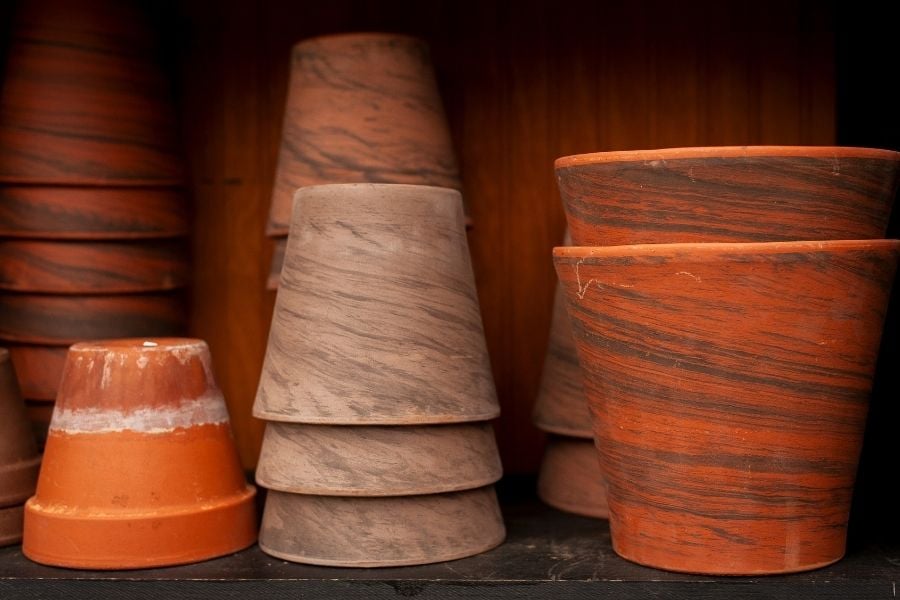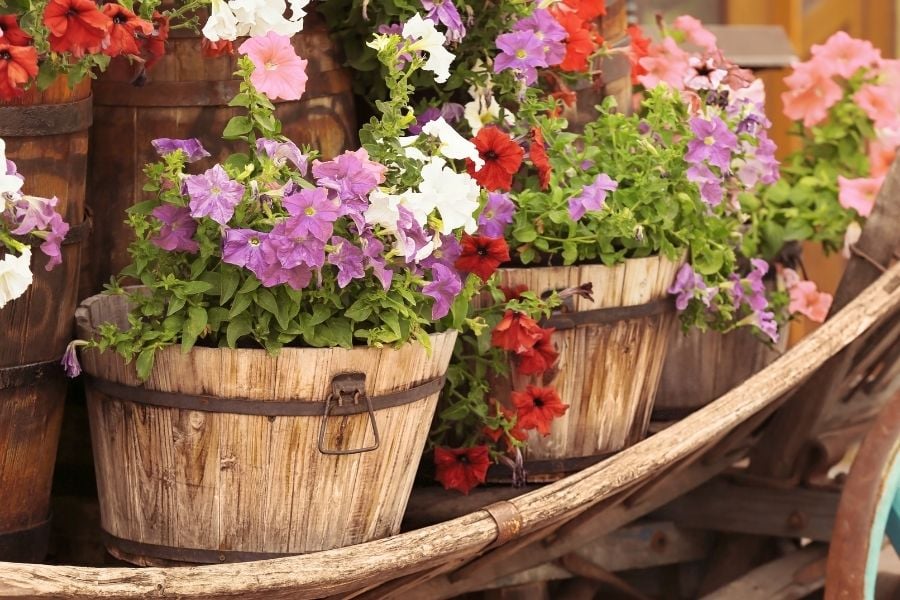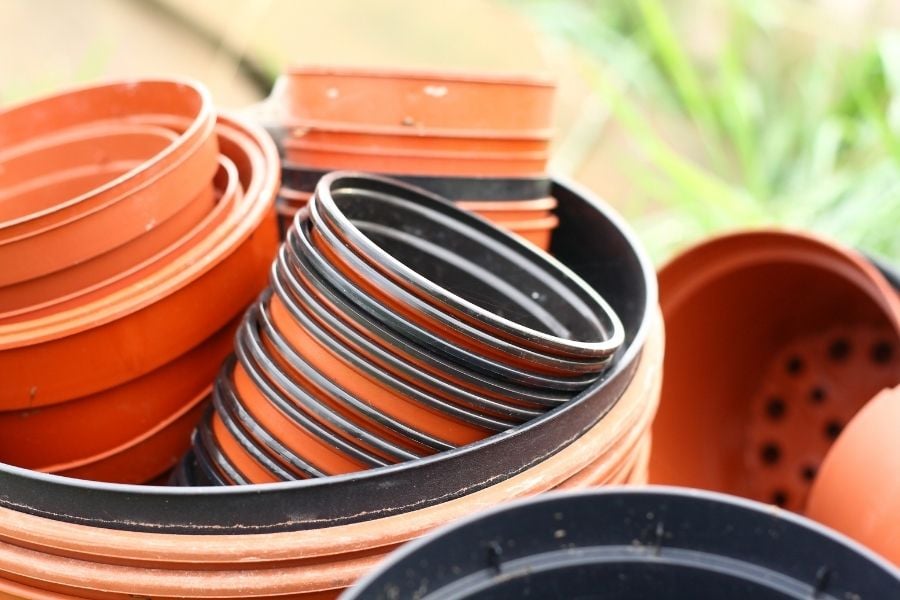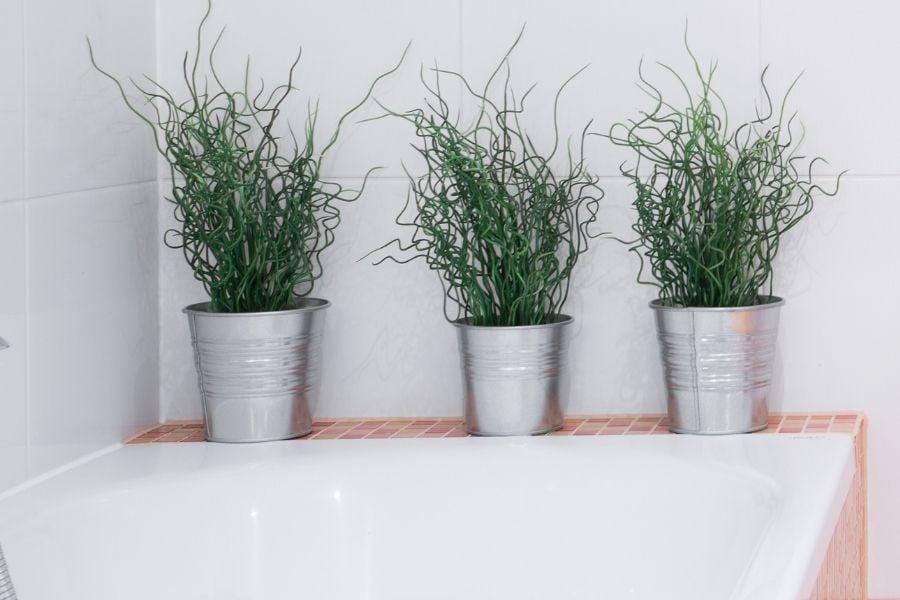There are so many different types and sizes of pots to use outdoors and it can get a bit overwhelming knowing what size pot to choose for your plants. There is no right answer, only the best pot for each plant. This blog will provide information on all you need to know about selecting the proper size, material, and color for outdoor pots for plants.
- 1. What are the best types of pot for plants?
- 2. What is the best shape for outdoor planters?
- 2. How do you choose the proper pot size for your plant?
- 3. Plant pot size chart and suggested plants
- 4. What is the best material for outdoor planters?
- 5. Tips on choosing the best color for outdoor pots
- What to do next
1. What are the best types of pot for plants?
That’s a difficult question and it depends on how much time and money you want to invest into your plants, and if the intended pot will be decorative or purely for agriculture. With the right planning, your outdoor planter can be both!
Let’s look at some possible scenarios
For cultivating plants
I recommend choosing a pot that uses natural materials like terra cotta or stone. These materials are water-permeable so they offer good drainage through evaporation. Good drainage means less chance of root rot and ensures the plant will likely reach its optimal growth potential once transplanted outside.
For container gardening neatness, choose a square pot so it will compact nicely in your gardening space.

For aesthetic purposes
Ornamental plant containers can really snazz up your container garden and make your outdoor space more beautiful. Fiberglass is a beautiful material that comes in hundreds of colors, shapes, and sizes so it’s easy to find the perfect fiberglass planter for your garden.
Fiberglass isn’t porous so to ensure better plant health, opt for drainage holes in the bottom.
If you want a solution that’s both beautiful and healthy for your plant, you can simply place the growing pot inside a larger, and more eyecatching ‘cachepot’ to get the best of both worlds!
What is a cachepot?
It’s simply a decorative plant pot that contains a more functional plant pot inside which is used to grow the plant. The ‘cachepot’ is used to hide the growing pot and display the plant in a clean and professional-looking way.
For planting in hardscapes
For planting containers on your patio, balcony, or rooftop terrace, fiberglass and plastic planters are a fantastic option because they’re extremely durable and weather resistant in cold and hot climates. This means your fiberglass planter will stay looking great all year round even in high traffic areas.

2. What is the best shape for outdoor planters?
Let’s look at some of the most popular planter shapes and sizes to see what may be best suited for your plants.
Round containers
Pros: Round planters are great if you’re planting a single plant and want to showcase it. They are the most popular plant pot shape because of their visual appeal.

Cons: Round pots don’t have the best soil and water carrying capacity compared to square containers because the corners of a round container are cut off.
Square containers
Pros: Square containers are fantastic for maintaining a uniform look in your outdoor space and they also stack easily when empty.
They are also said to be better for plant health as plant roots are less likely to turn into a ball compared to using round planters.

Cons: They don’t have the same visual appeal as some rounded planters. Though square planters look great in some gardens, it really depends on the aesthetic of your garden setting.
Rectangular containers
Pros: Rectangular containers offer excellent water and soil carrying capacity and they showcase a row of plants nicely – perfect for a hedge. They are also great for commercial growers or for growing edible plants at home due to their large area for cultivation.

Cons: Rectangle pots take up a lot of space and really suit specific design requirements, such cultivating a row of plants or creating dividing lines.
Jar, urn, and bowl containers
Pros: The shape of jar, urn, and bowl containers look very rustic and can complement a traditional and ornate looking garden, though modern bowl planters can look sleek and stylish. Flowers are often paired with urns.

Cons: Jars and urns that are tall and top-heavy are more likely to fall over in high winds so planting trees in them is not really advisable.
2. How do you choose the proper pot size for your plant?
This question is asked often and it really depends on the type of plant you’re growing, how big your gardening space is, and your personal preference.
General plant pot size rules
Generally, most plants will be ok with a pot that is 5 gallons, or 12 inches in diameter.
The container should be twice as wide and deep as the root ball for adequate growth.
Another good rule of thumb to follow is 1 gallon of soil per foot of plant height.
When in doubt, It’s always better to overestimate than under-estimate how much soil your plant needs to grow healthy
3. Plant pot size chart and suggested plants
This chart breaks down each plant pot size into inches, gallons, and how much soil is needed. We included a plant growing guide to help you choose based on your intended plant. For a full plant pot size guide, we have that too.

Large plants equals large planters
Choosing the wrong size can cause problems with your plant, especially if you are trying to grow a large plant that needs large pots. If your plant doesn’t have enough room, it may become stunted.
If you’re growing tall perennials, vines, shrubs or trees, you’ll want to use large and deep containers that can support the root system of your plant. Large planters also look fantastic. To see how to use them, check out our guide to decorating with large planters.

Small plants
On the other hand, if you have a small plant and choose a large pot, the roots might not reach enough of the soil to get enough water. Using a planter that’s too big is also a waste of soil and money.
If you’re growing a smaller plant like a herb, succulent or other small flowering plants, try choosing a pot that’s only 2 gallons. For succulents like small cacti, use a pot that’s 10% larger in diameter than the diameter of your succulent.

Consider the space
Small gardens
If you have a small space, it’s best to use pots that are more compact and don’t take up too much room. Rectangular plant pots that are longer than they are wide are great to pack in plants along fence lines. Choosing tall square planters also helps you save floor space while providing enough depth for longer roots.
Large gardens
If you have a larger area, you can afford the space to use larger planters. This is where your options really open up to small planters to extra large planters and everything in between.
Consider the cost of time and money
Large planters cost more. So if you’re on a budget, maybe consider plants that are small or are slow growing so you won’t have to re-pot too often.
A larger pot also needs more watering. If you don’t have much time to water your panters, consider growing smaller plants.

4. What is the best material for outdoor planters?
There are many types of planter materials and each type has its own unique features. Some materials are more durable than others, while some are weather-resistant, stain-proof, or retain moisture better or worse.
However, there is no “best” material for outdoor planters as it mostly depends on the aesthetics of your garden scheme, application, and personal preference.
For everything you need to know on material types, from terracotta to stone, check out our guide to planter materials.
Let’s take a quick look at the most popular planter materials on the market.
Stone planters
Stone is an excellent material to use for outdoor plant containers because it’s naturally antimicrobial (resistant to mold and mildew) and has excellent drainage properties.
Stone is available in a variety of colors to compliment any garden setting and comes in many different size options as well.
Though stone is widely popular for planters, there are downsides: stone can be pricey and heavy.

Wood containers
Wooden containers are another popular planter material. They are available in many colors and styles to complement any garden setting.
The downsides of using wooden containers are that they can be heavy. Also, wood planters won’t last as long as the other materials on the market due to moisture absorption.
Wooden pots are eco-friendly and, being made of natural materials, they won’t leach chemicals into your plant soil.

Plastic containers
Plastic is used to make inexpensive containers and great for starting off young plants. When you buy a plant from your local nursery, chances are that this will be the container that it comes in.
Plastic is lightweight and comes in many colors, shapes, and sizes. Also, a plastic container doesn’t have to be stained or painted, making it a very simple material to produce and maintain.

Concrete containers
Concrete planters are suitable for high traffic areas because they are heavy duty and durable as well as fairly weather resistant. They will also lose moisture quite quickly which is good for some plants.
Some concrete containers come in a wide range of styles. Some can be very elaborate, while others are basic. Concrete is readily available in different colors, smooth finishes, and textures to compliment your container garden.

Metal containers
Metal containers such as cast iron can rust, so if you are using this material, it is best to use it indoors or as an outdoor planter where it won’t get wet often.
Some metal planters can be very lightweight, however larger metal containers can get quite cumbersome.
Container gardening with metal planters isn’t advisable unless the planter has enough drainage holes to assist drainage as the material isn’t porous.

Fiberglass
Fiberglass planter pots are like plastic planters because they are extremely lightweight and the manufacturing process makes them very easy to mold into various shapes.
Fiberglass containers are made from glass. Fiberglass fibers are matted together to create a sleek and non-porous material. This means that holes are needed to provide adequate drainage.
Fiberglass pots are quite natural compared to plastic pots and healthier for your plant.
The only downside with fiberglass is that it can scratch easily, but this can be remedied by adding a protective coating prior to painting as most manufacturers do.
Related article: Composite planters 101

5. Tips on choosing the best color for outdoor pots
Choosing the right color for your container is equally important as choosing the proper size and material because as we’ll see, the color of the pot can have a big effect on the health of your plant too.
As a general rule, many experts agree that bright colors are best for increasing plant growth and productivity.
Decor
When selecting a pot color, it is important to consider the color of all your plants and accessories, as well as the colors in your garden scheme, fence, etc. Do you want it to stand out or blend in? Do you want a color that’s bright and accented, or one that’s toned down and minimal?
We created a full guide on planter colors for decor. It’s perfect for those with an eye for design.
Dark colors and light colors
In general, dark colors absorb more heat compared to lighter colors which reflect more UV rays.
Too much heat can dry out your soil quickly and leave your plant scorched. On the other hand, too little heat might lead to freezing in the winter, and this is also not good.
It is a good idea to use a lighter color if you are going to put it in a very hot area with direct sun to lessen the amount of heat absorbed by your pot.
Conversely, it’s better to use dark colors in colder regions to retain some of that direct sun into warmth for your plant.

Best colors for pollination
If you are growing plants for their flowers or vegetables, it is best to use light colors since this will help attract more pollinators like bees.
The main reason is that bright colors attract pollinators which increase your plant’s ability to reproduce.
Colors such as yellow, white, and light green are best for attracting pollinators to your garden.
What to do next
I hope we have answered all your questions about the best pots to use outdoors. If there are still some unanswered questions, I’m sure our blog will answer them.
As a planter manufacturer, we know how important plant containers are and want to help you meet the needs of your customers. We know that costs and quality are the most important factors, that’s why we chose Vietnam to manufacture our pots.
If you are trying to decide the perfect range of planters for your project, don’t hesitate to contact us. Before then, take a look at our advice on ordering custom planters.
